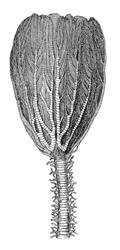|
|
Echinodermata |
| Echinodermata |
Crinoidea |
Class Crinoidea
(Cambrian? Ordovician-Recent)

The popular names for crinoids are "sea lilies" (for fixed crinoids) and "feather stars" (for free-swimming crinoids). There are several hundred species of stalked and unstalked crinoids inhabit the modern world's oceans, but this is just a tiny fraction compared to their abundance in past ages. The stalked forms inhabit the deep oceans, while stalkless forms are commonly found in shallower depths (including the shallows of coral reefs).
Crinoids have a cup-shaped head (the calyx) to which are attached long, branching arms. The food is transferred down the arms to the mouth by tube feet located on the pinnules and arms. The calyx is usually connected to the bottom via a stem.
There are usually five or a multiple of five arms, which may be repeatedly branched. Grooves in the arms channel food to the mouth, which is located in the centre of the calyx. Both the mouth and the anus are on the oral side of the calyx. Some paleozoic crinoids developed a symbiotic relationship with gastropods which would sit on the crinoid anus and feed on the shit (which was obviously rich in nutrients).
There are over a thousand known genera, mostly fossil forms
Evolutionary History
Organisms that have been identified as Crinoids first appeared in the early in the middle of the Cambrian period, although Conway Morris suggests these may actually be an extinct group of Cnidarians. Undoubted crinoids are known from the Ordovician period, by which time they had already become abundant and important. They became so numerous during the Palaeozoic era that their remains often form vast thicknesses of limestone. These great crinoid gardens probably lived in shallow water. The group as a whole suffered a major crisis during the Permian period when most of the crinoids died out, with a few surviving into the Triassic period. During the Mesozoic era there was another great radiation of the crinoids, with more modern forms possessing flexible arms becoming widespread. In the Cenozoic they again declined, and most species live in very deep water

Pentacrinites fossilis
Lower Lias. (Jurassic)
Lyme Regis, Dorset, England.
|
Most Paleozoic crinoids lived attached to the sea-floor by a flexible stem, which may be either cemented to the sea-floor, or have a root-like system buried into the sediment. Fossil crinoids have stems ranging in size from a few centimetres in length to as much as 21 metres.
Some crinoids, such as Pentacrinites shown in the illustration at the left, seem to have lived attached to floating driftwood and complete fossil colonies are often found. Sometimes the driftwood to which they were attached became waterlogged and sank to the bottom, taking the attached crinoids with it. The stem of Pentacrinites can be several metres long.
|
Classification
Detailed classification of the crinoids is based primarily upon the arrangement of the plates within the calyx, the number and branching pattern of the arms, and the external surface detail of the calyx. Internal features of crinoid anatomy, such as the nervous and respiratory systems, are also important
Subclass Camerata (Middle Ordovician - Permian)
Subclass Inadunata (Early Ordovician - Late Permian)
Subclass Flecibilia (Middle Ordovician - Late Permian)
Subclass Articulata (Triassic - Recent) The only living subclass of crinoids.
■─○
Crinozoa
└─○
Crinoidea
├─†
Disparida
└─┬─†"
Four-circlet crinoids"
└─┬─†
Camerata
└─┬─†
Flexibilia
└─┬─†
Cladida
└─
Articulata [ICZN rules, article 1 b4]
Reference(s):
iNet: Tree of Life --http://tolweb.org/tree/
Parker, S. P. (ed.), 1982: Synopsis and classification of living organisms. Vols. 1 & 2
--McGrew-Hill Book Company
page uploaded 15 June 2002
(originally uploaded on Kheper Site 11 May 1999)
checked ATW051226
page text
Creative Commons Attribution M. Alan Kazlev
this material may be freely used as long as attribution is given

